In the comments from my previous post on the Fine Art Photographer x Fujifilm X Series Photographs, it is apparent that some people don’t care for some or all of the photographs themselves. That’s fine, for of course art is highly subjective and not all things will appeal equally to each individual viewer. I think that’s great, as it leads to an intensely wide and extremely diverse body of work, even when restricting the selection of art to the relatively narrow field of photography.
At the time I was viewing the photographs in question, I did something I almost never do. Basically, I squinted with my eyes in an attempt to reduce the compositions themselves into block elements. I did this to render them devoid, as much as possible, of detailed visual information. The fine information that photographs (or any work of art) contain all help to build meaning or inform interpretation, whether this fine detail be such things as texture, small elements, smaller objects themselves, etc. My aim, while doing this, was to see the photographs as basic graphic compositions. I did this to help me understand why the photographs “worked,” because, I felt, they all in fact did work.
In Japan there is an abundance of photographic publications, be they magazines, mooks (magazine books) or books. They cover absolutely every conceivable photographic related theme, including composition. Right now at my somewhat rural local Tsutaya bookstore there are two composition books available (see photos below).
Typically, such books contain what I call ‘maru batsu examples.’ Maru is a Japanese term for a circle, and when used as an actual circle while marking (grading) something, means “correct.” On the other hand, batsu is an “x” mark used to indicate “incorrect” when marking. Typically, the composition books contain many pairs of similar photographs. One of each pair is (purportedly) good and indicated as such with a small maru mark, and one of each is (again, purportedly) bad and likewise indicated as such, this time with a small batsu mark (a triangle would mean half-way good or kinda okay). There is almost always accompanying text to explain or argue the point.
The other important feature of these books is the visual rule section. This contains graphic examples of composition rules (with accompanying text). Boxes are used to represent photo frames, and are filled with various straight and curved lines, circles, boxes and blobs, all to show compositional elements and how they can be ideally arranged to produce (supposedly) good compositions. Let’s be clear here, this goes way beyond the usual rule of thirds or golden mean offerings, and the rules given can be bewilderingly complex and the compositional dissection quite minute. Each rule is always accompanied by example photographs to illustrate the point. Again, see the photos below.
Anyway, as I squinted and looked at the Eggleston, et al. X-Series photos in question, I found that they all had something to offer in terms of recognisable gross graphic elements. Some were easier to spot than others, with several of the Eggleston and Goldin prints perhaps proving to be the most elusive. In this way I could identify potential reasons as to why these photos were successful, on a graphic level at least.
The first William Eggleston photo I show in this post for example, can be seen as something like a ‘golden mean’ sectioned space. All of the Martin Parr photos can been seen in terms of spreading diagonal lines originating in the upper left corners. The second Nan Goldin can be seen as mirrored elements (in a photograph of a mirror no less). The first Stephen Shore photo I show is a virtual visual cacophony of diverging / converging diagonals. Despite appearing quite round and organic, the first Terry Richardson can be seen to be a quite complex and symmetrical angular shape, centrally placed. In the first Ryan McGinny, the negative space under the arms, along with the torso and head, and the whole torso, head, arms structure itself are all pointed bars intruding into / leading to the empty space on the right.
Remember, squinting helps (well, me at least).
Of course, this is all subjective and only my own interpretation. I seriously doubt whether any of these photographers coldly planned their compositions to work, rulebook-like, in such a calculated way. But I’m also fairly confident that they are all aware, regardless of the degree of intuition or spontaneity with which they work, of exactly what is going on in a graphic sense.
It’s also important to note that the graphic element is not the whole story here (nor indeed, with any truly successful work). There is so much else going on, be it tone, colour, detail, subject matter, texture, context, subtext, etc., that is equally or even more important. That’s why I feel that, while being textbook perfect, the examples in the composition guidebooks often fail.
Regardless of the overall merit of approaching composition this way (viewing or constructing), I’m confident that something can be gained from considering these ‘rules,’ and even just studying the diagrams on the book covers in the accompanying photos below could be a useful exercise. There’s more than one way to ‘look’ at composition, and this is just one possibility.
One last note. An old high school English teacher of mine always said that one should read a book at least three times. Once to enjoy / experience the story at face value. Second time to analyse it, in depth. And finally, a third time to reconnect to the joy / experience of the story itself. This I think is a good way to look at photographs too, and what I tried to do that day at the exhibition.
Typed with a little help from St Hubert and the Agnostic Mountain Gospel Choir (here too)




















